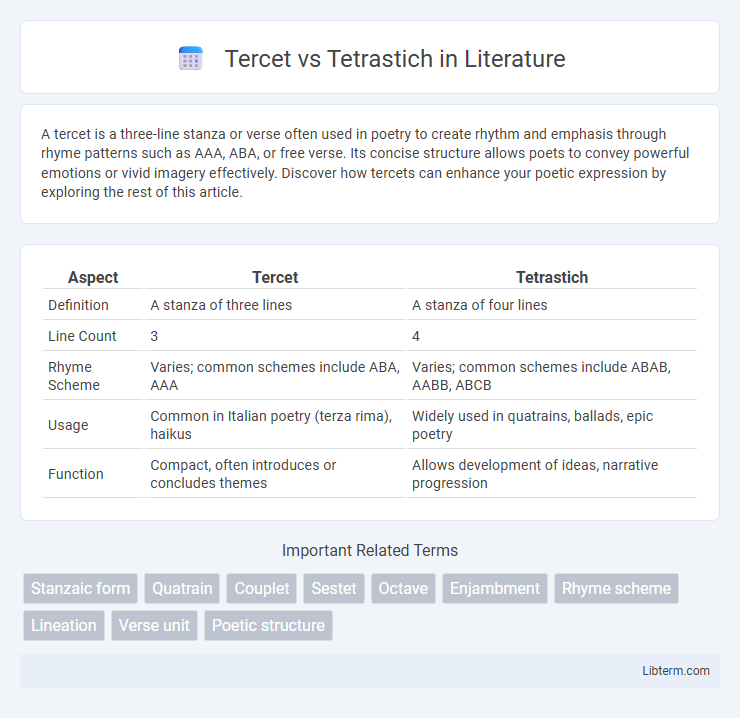A tercet is a three-line stanza or verse often used in poetry to create rhythm and emphasis through rhyme patterns such as AAA, ABA, or free verse. Its concise structure allows poets to convey powerful emotions or vivid imagery effectively. Discover how tercets can enhance your poetic expression by exploring the rest of this article.
Table of Comparison
| Aspect | Tercet | Tetrastich |
|---|---|---|
| Definition | A stanza of three lines | A stanza of four lines |
| Line Count | 3 | 4 |
| Rhyme Scheme | Varies; common schemes include ABA, AAA | Varies; common schemes include ABAB, AABB, ABCB |
| Usage | Common in Italian poetry (terza rima), haikus | Widely used in quatrains, ballads, epic poetry |
| Function | Compact, often introduces or concludes themes | Allows development of ideas, narrative progression |
Introduction to Tercet and Tetrastich
A tercet is a three-line stanza often used in poetry to create concise and impactful expressions, commonly found in haikus and terza rima. A tetrastich consists of four lines, providing a slightly longer structure that supports more developed ideas or a balanced rhyme scheme, as seen in quatrains and ballads. Both forms serve distinct rhythmic and aesthetic purposes, shaping the poem's flow and emotional resonance.
Defining Tercet: Structure and Purpose
A tercet is a three-line stanza commonly used in poetry, characterized by its compact structure designed to convey a single idea or image with rhythmic precision. Each line can rhyme in various patterns, such as AAA or ABA, offering flexibility in melodic expression and thematic emphasis. This concise form often serves to intensify emotional impact or highlight a pivotal moment within a poem's broader narrative.
What is a Tetrastich? Key Characteristics
A tetrastich is a stanza or a complete poem consisting of four lines, often structured with a specific rhyme scheme such as ABAB, AABB, or ABCB, which enhances its rhythmic and melodic qualities. This poetic form is known for its brevity and compact expression, allowing poets to convey vivid imagery or poignant emotion within a concise framework. Key characteristics of a tetrastich include its four-line format, varied rhyme patterns, and the potential for both narrative development and lyrical intensity, making it a versatile choice in poetry composition.
Historical Origins of Tercets and Tetrastichs
Tercets, three-line stanzas, trace their origins to medieval Italian poetry, notably in Dante Alighieri's "Divine Comedy," where the terza rima rhyme scheme popularized the form. Tetrastichs, four-line stanzas, have roots in ancient Greek and Latin poetry, evolving through classical forms such as elegiac couplets and quatrains in European ballads and sonnets. Both forms shaped the development of Western poetic structures, reflecting distinct cultural and historical influences over centuries.
Tercet vs Tetrastich: Structural Differences
A tercet is a three-line stanza with a rhyme scheme that often follows patterns such as AAA or ABA, emphasizing brevity and concise expression. In contrast, a tetrastich consists of four lines, commonly adhering to rhyme schemes like ABAB or AABB, allowing for more expanded thematic development. These structural differences influence the rhythm, pacing, and emotional impact within poetic compositions.
Famous Examples of Tercets in Poetry
Tercets, three-line stanzas often with a rhyme scheme like AAA or ABA, are prominently featured in renowned poems such as Dante Alighieri's "Divine Comedy," where the terza rima form employs interlocking tercets. Emily Dickinson frequently used tercets to convey concise and powerful imagery, exemplified in poems like "I felt a Funeral in my Brain." Unlike tetrastichs, which consist of four lines and are common in quatrains, tercets create a distinctive rhythm and compact expression favored in classical and modern poetry.
Notable Tetrastichs in Literary Tradition
Tetrastichs, four-line stanzas, play a significant role in literary traditions, with notable examples like the Rubaiyat of Omar Khayyam, celebrated for its quatrains blending philosophical depth and lyrical beauty. The Greek epigram often employs tetrastichs, encapsulating poignant messages in concise, impactful verses. Tetrastichs serve as versatile building blocks in poetry, distinguished from tercets, which consist of three lines, by allowing a broader rhythmic and thematic development.
Thematic Uses: When to Choose Tercet or Tetrastich
Tercets, consisting of three lines, often suit themes requiring concise, impactful expression or a rapid progression of ideas, making them ideal for moments of emotional intensity or lyrical clarity. Tetrastichs, composed of four lines, provide a more balanced structure that supports thematic development, narrative expansion, or reflective depth, frequently used in quatrain-based forms like ballads or hymns. Choosing between tercet and tetrastich depends on the desired thematic emphasis: tercets emphasize brevity and immediacy, while tetrastichs offer space for elaboration and thematic complexity.
Writing Tips for Crafting Effective Tercets and Tetrastichs
When crafting tercets and tetrastichs, focus on maintaining clear rhyme schemes and rhythmic consistency to enhance flow and memorability. Use vivid imagery and concise language to create impactful stanzas within the three or four lines, ensuring each line contributes meaningfully to the poem's theme. Experiment with enjambment and varied meter to add depth and musicality without compromising the structural integrity of the tercet or tetrastich.
Conclusion: Enhancing Poetry with Tercets and Tetrastichs
Tercets, consisting of three lines, and tetrastichs, composed of four lines, each bring distinct rhythmic and thematic possibilities to poetry, allowing poets to craft varied emotional impacts. The concise structure of tercets intensifies lyrical expression, while tetrastichs offer more space for narrative development and complexity. Mastering both forms enhances poetic versatility, enabling richer, more nuanced literary creations.
Tercet Infographic

 libterm.com
libterm.com